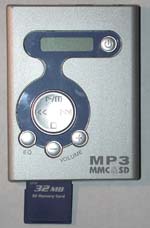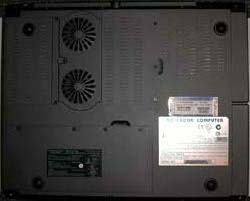Sager NP8886 2.8GHz Pentium 4
by Matthew Witheiler on January 21, 2003 4:56 AM EST- Posted in
- Laptops
Construction - Build, Appearance, Size (continued)
As large as the Sager NP8886 is one would fully expect it to be a feature rich desktop replacement. Looking at the front of the system gives us a peak of what the NP8886 holds in store for us. The front face of the system includes an "Audio DJ" system for CD playback while the notebook is powered off. With the press of a few buttons, the Audio DJ system provides the user with all the features of a standard CD player. The advantage of this system is that the unit does not need to be booted in order to play audio CDs, saving immense amounts of battery life if all you want to do is listen to some music. It also eliminates the need to bring a separate CD player on trips where music is desired.
The unit's speakers are located on the left and right side of the front face of the NP8886. The unit was large enough that the speakers were not covered while typing thanks to a large wrist rest area.
We had a slight problem with the screen release lever on the NP8886. Soon after receiving our test unit, the lever started getting caught while attempting to open the screen, preventing it from locking once the notebook was closed. The spring may have been getting caught or the plastic a bit bent but regardless of the cause it was a bit frustrating to continually have to force the lever closed.
Just the left side of the Sager NP8886 offers more features than we are used to seeing on all sides of other notebooks. At 2.15" thick (that larger than two of the ASUS S1 machines stacked on top of one another) there is plenty of space for components on the system. Towards the front lies the unit's drive bays. The floppy drive is non-modular and rests on the top half of the notebook. The bottom half is reserved for the optical drive of choice. In our case the unit was configured with a DVD/CD-RW combo drive operating at 8x24x10x24x but the system can also be shipped with a 24x CD-ROM (the standard optical drive), an 8x DVD-ROM drive, or a 16x10x24x CD-RW drive.
The space to the left of the optical drive bay is actually a second drive bay. The bay can accept any of the optical drive solutions or a hard disk drive as it was in our case. Obviously when configured with an optical drive the system contains two optical solutions, useful for those who do regular CD copying and until now a feature that we have not seen on a notebook computer. Perhaps more useful is the ability of the bay to accept a hard drive, resulting in two internal system hard drives. Also the first time we have seen this in a notebook, our NP8886 came with two internal hard drives. Although the drives are not RAIDed (there is no RAID chip in the system), a software RAID could be setup using an appropriate application. Being bulky does have its advantages.
There are also two type-II PCMCIA slots on the unit's left side. You can get an idea of exactly how large the NP8886 is by noting how little space is taken up by the two slots. Whereas some other notebooks have trouble fitting two slots on the system it looks as if the NP8886 has room to stack at least five type-II PCMCIA slots vertically.
Moving further left on the NP8886 we find the system's internal memory stick reader. The port is used to read memory stick devices produced by Sony and frankly we are not too sure why the NP8886 incorporates this reader. Typically only Sony produced electronic components support the memory stick format such as Sony cameras and PDAs. As a fairly proprietary technology the memory stick reader is of limited use except to those who already have a strong base of Sony products. Why did Sager include the reader in the unit? Probably because they could, incorporating the "everything but the kitchen sink" mentality of the NP8886.
The final items on the left side of the NP8886 are the system's IR port (small black square) and audio-out ports. Like the Hypersonic system we looked at last week, the NP8886 is also able to output in S/PDIF digital output.
What is not offered on the left side of the NP8886 is most likely located on the back of the system. The NP8886 includes your standard ports, an ethernet and modem jack, PS/2 port, a parallel port, a serial port, and a s-video out port, but also includes some special features. The NP8886 is one of the first laptops we have seen offer a 6-pin firewire port as opposed to the 4-pin min-firewire port that is prevalent on many of today's notebooks. We have heard talk of manufacturers switching over to the 6-pin port on notebooks due to customer demand: very few devices use the 4-pin connection out of the box and even fewer come with 4-pin to 6-pin converters necessary to use 6-pin devices on 4-pin ports. Keep in mind that the IEEE-1394 port, although 6-pinned, is unpowered. The port is of the big type that is normally powered but does not carry power along the two power pins. This design is implemented to prevent firewire devices from draining the system battery while the notebook is unplugged.
Also on the expansion port side are a set of four USB 2.0 ports. More and more notebooks are coming with USB 2.0 standard and we could not be more pleased, it is a very useful feature to offer especially on a laptop where upgrade paths are fairly limited.
One real special feature of the NP8886 is its built-in TV tuner with remote control. Frankly this is something we never would find its way into notebook computers but Clevo and Sager found a way to put a full TV tuner inside the NP8886. The TV tuner is similar to desktop solutions by ATI or Hauppauge, albeit less refined. The small hole below the serial and VGA-out port on the unit is where the cable input is placed. A small threaded dongle is used to extend this hole slightly out of the system's back to allow for the coaxial cable to be secured. As you will see in the software section, the TV tuner allowed us to use the NP8886 as a television and even supports PVR (personal video recorder) functions. Again, we never suspected that TV tuners would find their way into notebooks any time soon (their analogue components take up a good amount of room and there are a number of USB TV tuner solutions on the market) but if it can fit in the 12 pound box that is the NP8886, Sager put it in there.
Along with the TV input is a composite/s-video input connection. Again, this is something we have never seen on a notebook before and it gives the NP8886 a feature that many desktop systems do not have.
The most eye catching item on the right side of the Sager NP8886 is the large cooling vent on the bottom back side of the system. Clearly there is some intense heat exchange occurring in this region, something we would investigate in more depth when we took the system apart. For now it is important to know that this portion of the notebook got up to 139.5 degrees
If you look closely at the right side of the NP8886 you may notice something else: a small silver button and a rectangle shaped cutout towards the front of the system. The rectangular cut is actually the home to the NP8886's internal and removable MP3 player and the small silver button is the release lever. Much like the removable player seen on the ASUS T9 notebook, the NP8886's MP3 player is a pocket sized player. The unit, called the Newtrend MP3 player, accepts SD or MMC memory chips at up to 128MB in size. The unit ships with a 32MB SD card to get you started right away and takes two AAA batteries.
As an MP3 player, the unit is very basic. There are buttons for power, play/pause, track forward, track back, stop, volume and equalizer (to choose between a number of set equalizer settings). The LCD panel displays only track number and play time of the current song, a far cry from the advanced features of MP3 players today. The simple display makes navigating songs fairly cumbersome, able only to go from 1 to 2 to 3 and so on without being able to see any of the MP3 tag information.
Writing to the memory card inserted in the MP3 player is accomplished not by a proprietary application (like in the case of the ASUS machine) but simply by clicking and driving MP3 files to the player which shows up as a removable storage device under Windows XP. This proved to be much easier and more reliable than the ASUS software we encountered before.
The top of the MP3 player features a headphone jack and a mini-USB port for connecting the player to systems other than the NP8886.
The bottom of the NP8886 gives us a glimpse of the extreme cooling that the unit employs. There are two large fan cut-outs towards the back left side of the system. These fans suck cool air from beneath the unit and blow it across the heatsink surface via the exhaust on the unit's right side. In order to ensure that the fans have a sufficient pool of air from which to draw upon, the NP8886 rests on four large feet that place the unit almost a half inch off the surface that it is resting on; a bit high in our opinion especially considering that the large height of the system already places it fairly height. The feet on our review sample quickly fell off under normal use but it was nothing that a bit of super glue or double sided tape could not fix.
There are two removable access panels on the bottom of the NP8886. On the left side, by the fans, is an access panel that removes to show the system's heatsink. Removing the heatsink reveals the system's CPU, making access to the desktop Pentium 4 processor easy.
To the right of the fans lies the TV tuner module. Since the TV tuner is a factor option, it can be removed or added in at later times via this access panel. Removing this access panel is also necessary to gain access to the removable drive bay located on the back right side of the unit.
The battery in the NP8886 is actually screwed into place. Located on the front side of the system, the battery can only be removed by unscrewing four screws. An interesting setup if you ask us; clearly the battery on the NP8886 is not meant to be removed often (to reduce travel weight, for example). The battery is rated at 6000mAH, making it quite powerful. Once the battery is removed, the primary internal hard drive is revealed which is perhaps the reason that Sager turned to screws to keep the battery in place. Removed in the picture below, the primary hard drive rests in a caddy that sits at about the middle of the system's front.
















0 Comments
View All Comments